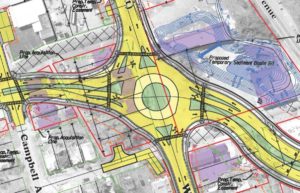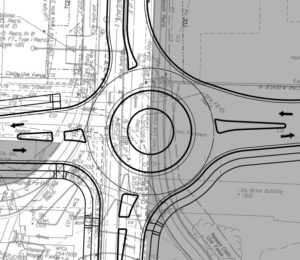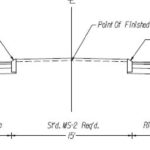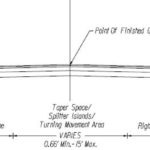Earlier this year, I wrote about how I think the city of Roanoke’s plan for a large roundabout on 13th Street SE is bad and will make bicycling worse for no clear benefit. In 2020, the city submitted a new version of this project to Virginia’s SmartScale funding program – Project ID: 13th Street Southeast Improvements.
This new application is much improved.
They Changed the Roundabout for the better
- The biggest difference is the change from a multi-lane roundabout to a single-lane roundabout. This should make a big difference for bicyclists using the well-traveled route from downtown Roanoke to Fallon Park along Campbell/Wise Ave. A single-lane roundabout is much easier to navigate as a bicyclist as there are fewer conflict points.
- The single-lane roundabout also does not have a slip lane for motorists, which was a feature in the 2017 version of this project that would have created a conflict point between speeding motorists and bicyclists exiting the roundabout.
- While the single-lane roundabout design is a big improvement, the city should still pay close attention to the design of the roundabout to make sure that it prioritizes safety and low speeds. It is hard to tell from the drawings associated with the project if the city plans to provide ramps for bicyclists who would prefer to cross the roundabout as a pedestrian rather than riding through like a vehicle.
It’s unclear how this project affects Dale Ave – which could be a great bike boulevard
The current available drawings only go to Church Ave, a few blocks from the intersection of 13th Street and Dale Ave. I think Dale Ave has the potential to be a great bike route and provide a lower traffic and lower speed alternative to Campbell/Wise Ave. Currently, due to past ambitions to make 13th Street a higher speed four lane arterial roadway, the intersection of 13th Street and Dale Ave has a lot of empty space and could be made significantly safer. Due to the available drawings not including this intersection it is impossible to tell what the city might do.
The project has bike lanes, but doesn’t try to be great for bikes
The typical cross-section for 13th Street in the application shows five foot bike lanes and 11 foot travel lanes, with a median island of up to 15 feet. I think there are three ways this misses an opportunity to provide better bicycle facilities for people:
Bike Lanes Should Not Include Gutters
The five foot bike lane includes three feet of bike lane and two feet of gutter. Unless done very well this will create a less smooth facility over time and decrease the usable area to less than five feet. It would be better to have at least four feet of bike lane excluding the gutter pan.
Repurpose Median Width to Better Bike Lanes
Medians can be great and can help create a pleasant and safe environment through tree canopy. But, a 15 foot median is more than is needed for any turning movement of a car in a turn lane and I would prefer larger bike lanes, or striped bike lane buffers, instead of excess median space. The FHWA Bikeway Selection Guide puts this street right on the border between buffered bike lanes and separated bike lanes as a preferred bike facility.
Narrower Lanes for Low Speed
The cross section has 11 foot travel lanes. This is typical of Roanoke, but is likely to make some drivers speed. Going below 11 feet might allow a larger bike lane that didn’t rely on the gutter pan for 40% of its width.
This is still a pretty low scoring project on Virginia SmartScale, scoring 1.4. That score gives it a state rank of 250 and a district rank of 25. This might be a slight improvement from the last round and may reflect that this is a less ambitious project – because it does not include the bridge over railroad tracks proposed in 2017. That bridge would probably add at least $10 million to the project cost and was one of ten priorities stated by 2020 Mayoral Candidate David Bowers. While the Virginia SmartScale doesn’t see a lot of value in this project, it appears that city leadership may see value due to this second application and was a stated priority by a political challenger.
Update: David Bowers was defeated in the Nov. 3rd election.




